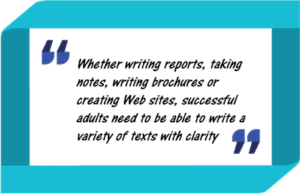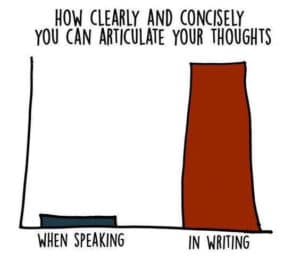Why Writing Matters
January 9, 2018 January 30, 2022
Why is writing such an important part of instruction?
The Common Core Standards set the expectation that students will be adequately prepared for a 21st century economy and the demands of college and careers. In regards to writing, standards require students to “produce clear and coherent writing in which the development, organization, and style are appropriate to the task, purpose, and audience.” Meeting this expectation requires educators to understand writing development, and to redefine their understanding of rigor and embrace the notion that challenging students is not about inundating them with more work. Instead, assignments must be created that are standards-driven, infused with higher level thinking, and integrate writing. Students must be able to analyze, explain and develop clear, accurate and effective writing on any given subject area topic. This means that students will need to be able to write for a myriad of purposes and styles.
Why is writing critical in all content areas?

Writing is no longer the responsibility of English teachers alone (check out our RAFT writing across the content areas guide). The demands of today’s jobs require students to know how to communicate effectively using a multitude of formats.
- The NCTE urges teachers of all subjects to use writing, saying that it is “integral in every subject.”
- The NCTM states that students must “recognize the importance of reflecting on their own thinking.”
- The NSTA refers to “performance assessments,” “portfolio construction,” and “writing challenges” in its position statement on assessment.
It’s impossible for students to meet any of these expectations without writing!
How Writing to Learn strategies foster comprehension?
Writing to Learn is an evidence-based instructional practice that does “double duty” as it enhances student learning and helps teachers to tailor instruction immediately to student needs. Mondschein-Leist (1997) suggests that writing-to-learn assignments can be used to stimulate discussions, monitor overall understanding of a class or individual student, or reinforce the learning of information that students have not yet mastered. Attention is focused on ideas rather than the correctness of style, grammar, or spelling. It is less structured than disciplinary writing. Often, these writing tasks are limited to less than five minutes of class time or are assigned as brief, out-of-class assignments.

Writing to Learn activities help students to represent their understanding of new knowledge and skills, which will help them to successfully master challenging content and advance their overall learning. Activities such as graphic organizers, paragraph frames, and structured notes are excellent resources for helping students write and respond to assignments that utilize higher order thinking strategies and processes. Quality lessons move students through the levels of learning and culminate in an assignment that is aligned to the higher levels of thinking. Because writing is thinking on paper, it is a critical component of all effective assignments. Writing allows students to analyze, reason, and apply new knowledge and skills in a way that communicates evidence of understanding.
What can we do better?
Writing to Learn activities are not about creating polished, ready to publish products. They are meant to deepen student understanding of content and to advance student learning. The purpose for these types of activities is for students to grapple with course content and think about the learning by engaging in tasks that require them to summarize, clarify, and explain, pose questions, build connections, reveal confusion, shape meaning, and/or reach understanding.
This approach frequently uses…
- journals
- logs
- responses to written or oral questions
- summaries
- free-writing
- notes
- other writing assignments that align to learning ideas and concepts.
Any accompanying feedback or grade must focus on strengthening the quality of your instruction by guiding your understanding of student learning.
References:
Writing Reminders: Tools, Tips, and Techniques (Burke, Jim 2003)
Writing to teach: writing to learn in higher education (Mondschein Leist, Susan R. 1997)
